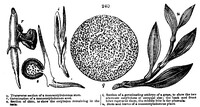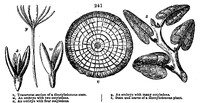1022. Endogens, or Monocotyledonous plants, are the first remove from Cellulares, and hold an intermediate rank between them and Exogens or Dicotyledonous plants, in which vegetation acquires its highest form of developement. They were formerly characterised by having a single cotyledon; but this circumstance is not only not absolute, but difficult of determination, except after minute analysis. The principal real difference between the seed of them and Dicotyledons is this, that in Monocotyledons there is only one cotyledon (fig. 240. s.); or, if two, that they are alternate with each other (t), while in Dicotyledons they are always opposite, and more than one, sometimes several, as in Pinus (fig. 241. y). The physiological structure of the two classes is, however, that by which they are familiarly distinguished, and exhibits a beautiful proof of the harmony that exists between the great features of vegetation and their first principle, the seed from which they originate. In Endogens or Monocotyledons, there is no distinction between wood and bark (fig. 240. q.); in Exogens or Dicotyledons, the wood and bark are distinctly separated (fig. 241. v.). In Monocotyledons the wood and cellular tissue are mixed together without any distinct annual layers of the former being evident; in Dicotyledons the wood and cellular tissue have each their particular limits assigned them, a distinct layer of the former being annually deposited. In Monocotyledons there are no radiations from the medulla to the bark; in Dicotyledons the radiations are generally distinctly marked. In Monocotyledons there is generally no articulation between the leaves and the stem, while in Dicotyledons the leaves are always jointed with the stem, from which they fall off, leaving a scar behind. In Monocotyledons the veins of the leaf pass in parallel lines from the base to the apex, in Dicotyledons they diverge from the midrib towards the margin at various angles; in the former they are unbranched, the principal veins being connected by nearly simple secondary veins; in the latter they are much branched, ramifying in many directions, and giving the surface of the leaf a reticulated, or netted appearance. In exception to these remarks, a few Monocotyledons are known to exist, the veins of whose leaves are considerably reticulated.



